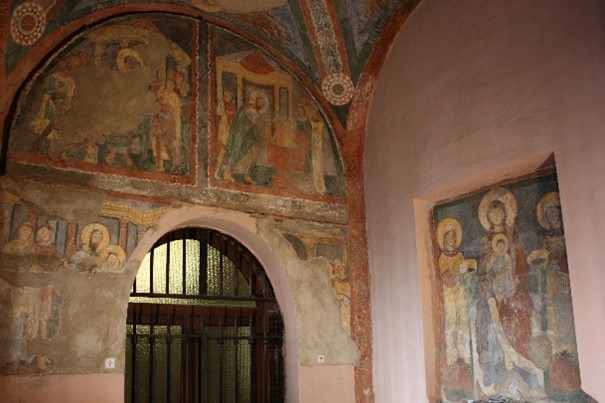La struttura della Basilica di Santa Pudenziana, per volontà di Costantino, deriva dalla trasformazione in luogo di culto di un antico locale termale del II secolo costruito sulle rovine della casa del senatore Pudente che ospitò gli Apostoli Pietro e Paolo, divenendo così una Domus Ecclesia “Chiesa Domestica” con il Titulus Pastoris del 154 d.C. Successivamente fu ampliata e conosciuta col nome di Ecclesia Pudentiana, come scritto nel mosaico del V secolo.
Nel XVI secolo il Cardinale Caetani diede alla chiesa l’attuale struttura barocca, costruendo un tetto a volta a vela che sostituiva l’antico tetto in legno a capriate.
Costruì sopra il presbiterio una cupola ellittica e trasformò in cappelle le due navate laterali, che originariamente erano i camminamenti delle antiche terme intorno alle vasche che attualmente si trovano sotto il pavimento della navata centrale.
Biglietto intero + 18 anni € 10,00
Biglietto ridotto € 6,00
La visita comprende: Visita guidata della Basilica, accesso agli Scavi e all’Oratorio Mariano con personale addetto
Visite su richiesta: prenotazioni per gruppi o richieste di visite speciali scrivere a incoming@orp.org
Il sito dista 10 minuti a piedi dalla Stazione Termini:
Il sito dista 5 minuti a piedi da Fermata S. Maria Maggiore

Santa Pudenziana preserves the oldest of the great apsidal mosaics of Christianity dating back to 410-417 AD, and which served as a model for the Byzantine mosaics of the Pantocrator of the following centuries.

For the first time in tens of years, the Archaeological Excavations underneath the Basilica are accessible - although with a restriction to small guided groups - with the remains of the 1st century house of Pudente where Peter and Paul lived. A unique experience of immersion in ancient Rome!
Excavations of over 1000 square meters contain other testimonies up to the second century. B.C.
Among these finds, the remains of two floors of an ancient Roman Insula from the second century are worthy of note, with some of the rooms used as a shop on the ground floor
hide
Another jewel preserved in the premises of the Basilica is the ancient Marian Oratory, embellished with frescoes from the 11th-12th century. In particular, the fresco representing the baptism of Pudente's family by St. Peter.

In one of the side chapels Cardinal Enrico Caetani built his and his family's mausoleum, in particular of his brother Onorato, one of the leaders of the papal troops in the battle of Lepanto. The Caetani Chapel is one of the jewels of Baroque art in Rome
In addition to mosaics and a beautiful inlaid marble floor, the chapel is embellished with a Carrara marble high relief representing the Adoration of the Magi and dominates the altar.
hide